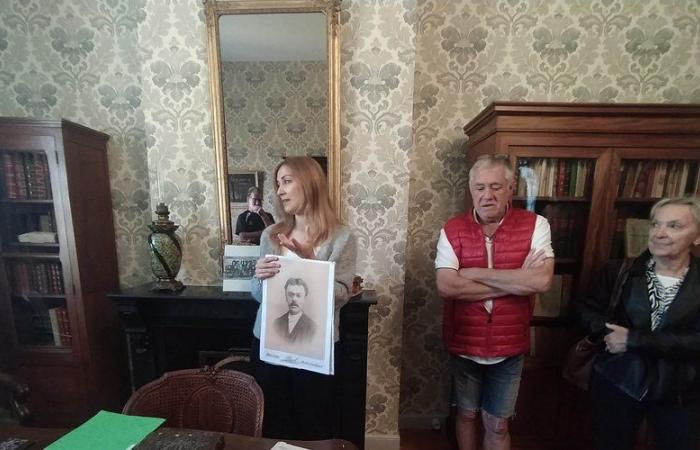Every month, the Béziers tourist office offers a guided tour of the family apartment where the illustrious Jean Moulin grew up. If everyone, or almost everyone, knows the tragic end of the resistance fighter tortured by the Nazi Klaus Barbie, after his arrest in Caluire near Lyon, the family history of the man who was prefect, resistance fighter and artist, entered the Pantheon in 1964, is often ignored by the general public.
This Wednesday, October 30, around ten visitors are preparing to enter the building at 6 rue d'Alsace, in Béziers, where Jean Moulin lived until he was 18. Open to the public since May 2023, the 60 m2 apartment located on the 4th floor, restored “as in the times”, is made up of 5 rooms structured around a hall. The rooms are paved with original tiles, the same ones that Jean and his family walked on, made up of Blanche, his mother, Antonin, his father, and Laure, his dear sister to whom we owe many anecdotes about their daily lives, recounted during the visit by the guide, Manon: “There are a lot of women at the Moulins, they like to surround themselves with young people and often welcome their nieces, who come to study in Béziers, I let you imagine the commotion to receive all these beautiful people.”
“Everyone rejoices at his birth”
Especially since the apartment only has one master bedroom, where little Jean Moulin sleeps until he is two or three years old. He is the only one to be born in Béziers, in 1899, among four siblings including a sister and a brother who died prematurely. “Everyone is delighted with his birth, his father in particular, who writes him a poem in Provençal.” Two servants also live in the apartment, one of them, Maria, is in love with the soldiers who run the Guesclin barracks, located on the square in front of the apartment and “loved watching the soldiers train every morning. Jean was his excuse to go down for a walk and see them, which he loved too. When he didn't want to go out, she bought his silence with candy.”
Facetious, even irreverent, he is fond of puns and caricatures.
Throughout the pieces, the pantheonized future is described as facetious, even irreverent. A fan of word games, he transforms the sentences of the catechism, taking into account the secularism of his father Antonin, a teacher who makes his children learn the declaration of human rights by heart, and who spends his time in the library office. This room, where there is a philosophy textbook belonging to Jean, allows us to evoke his life as a schoolboy, thanks to copies of school reports and dissertations:“In CM2, it is said that he neglects his writing and chatters in class, that he is restless and distracted during his lessons, in 6th grade, that he must watch his behavior despite good work or he will not do anything good if he perseveres on this path.
In this room, Jean spends long hours with his father, who locks him there to make him recite his Latin lessons, ending in arguments “since Jean was only doing what he wanted” Sister Laure will report. In one of his duties, Jean-Moulin glorifies the figure of Vercingétorix, who died defending his homeland, a premonitory tutelary figure… It is also in this office that the father locks himself with relics of his eldest, Joseph, in fragile health, died at the age of 19 from peritonitis. This big brother who always helps his younger brother, Jean, win at the game of little soldiers.
“He compartmentalized his life according to who he was with”
It was in the dining room, where we can see two photos of Jean and his sister, that in 1926, while sub-prefect in Albertville, he surprised his entire family, seated at the table, by announcing an engagement to a Parisian woman. : “He compartmentalized his life a lot depending on who he was with. With his family, modest and reserved, he did not reveal his feelings. With his friends, in the Montparnasse district where he frequented the artistic elite, he was expansive and jovial, then in as sub-prefect, he was rigorous and strict.”
It is also in this apartment that the future resistance fighter will learn to draw at the age of 5-6, with his colored pencils offered by a neighbor, whom he thanks by caricaturing her in unflattering proportions. “Failing to listen, in class, little Jean caricatures his teachers” laughs the guide, who relates that during the work, Jean transforms, remains wise, concentrated for hours on end. His very first sketch depicts a soldier, probably observed from the window or during walks with the servant Maria. Caricatures of professors as Napoleon followed, up to illustrations published in magazines; these drawings are kept in the superb Daniel Cordier library of the media library.
Romanin, the other Jean Moulin, can be discovered at the media library
Within the André-Malraux media library there is a showcase. The personal library of Daniel Cordier that the illustrious secretary and biographer of Jean Moulin bequeathed to the city of Béziers. In this room located on the first floor is the almost complete collection of books and works that belonged to him but also an impressive wooden secretary and above all, a collection of drawings stored in an imposing wooden library, made by the other Jean Moulin, Romanin. The room, which is only accessible by visit, is worth a look, as the genius of the line applied by the designer and resistant, seduces the eye. From Montparnasse of the Roaring Twenties to scenes of country life or the working world, Jean Moulin sketches French society of the time with a tender and funny or acerbic and critical look, when it comes to denouncing, for example, the late involvement of the United States in the First World War. The city has 500 drawings by the resistance artist, including 13 dedicated to bullfighting. An unmissable detour, which goes hand in hand with the guided tour of the family apartment at 6 rue d'Alsace.
Next visits: 11/16 and 12/26 from 2:30 p.m. to 4:30 p.m., 8th/6th grade. Resa: 04 99 41 36 36






